Archive:Employed people and job starters by economic activity and occupation
Data extracted in April 2021
Planned article update: July 2021
Highlights
Since the outbreak of the COVID-19 pandemic in early 2020 in Europe, many companies have been struggling with the balance between health-related measures and finding a way to continue to produce goods and provide services to preserve their existence. Many were not able to maintain the same levels of production as before the COVID crisis. To mitigate the social impact of the pandemic, the European Union (EU) and national governments introduced a variety of measures, including fiscal support or loans. Although protective measures to preserve the level of employment have been taken, a more cautious policy of enterprises in regards to hiring new employees could be expected. In addition, there might be more reluctance to start new businesses, which could have also led to more employed people.
The aim of this article is to shed light on this topic and to report about developments for recent job starters. Information on recent job leavers is also presented to complement the picture of the labour market dynamics. The two groups are defined in the following way:
- Recent job starters are people who reported that they started their current job in the last 3 months before the interview.
- Recent job leavers are people who reported that they left their job in the last 3 months before the interview;
This article is based on the European Union Labour Force Survey (EU-LFS) quarterly results, both seasonally and non-seasonally adjusted data are used. The European and country approaches are presented, in order to show the effect of the COVID-19 crisis at the global EU level and at the national level in the individual Member States, as well as in three EFTA countries (Iceland, Norway and Switzerland) and four candidate countries (Montenegro, North Macedonia, Serbia and Turkey). This article is part of the online publication Labour market in the light of the COVID 19 pandemic - quarterly statistics along with the articles Employment, Absences from work and Hours of work.
Full article
Recent job starters outnumbered again recent job leavers in the third and fourth quarter of 2020
Figure 1 presents the development in the number of recent job starters and recent job leavers over the period 2006-2020 in the EU. The levels of the two groups got closer together and moved further apart from each other over time. For example, in the first quarter of 2009, a period that is associated with the financial crisis from the late 2000s, the numbers of recent starters and leavers were very close to each other. In this quarter, 6.8 million people were newly employed, whereas 5.2 million had recently left their jobs.
However, despite the proximity of these two groups over the years, the number of recent job leavers has never surpassed the number of recent job starters, up to the second quarter of 2020 (Q2 2020). During this quarter, recent job leavers outnumbered recent job starters by 1.3 million, reaching a record high for the whole time series of 6.3 million. The number of recent job starters in the same quarter reached a historical low of 5.0 million in contrast.
The situation during the third quarter of 2020 (Q3 2020) changed: the number of recent job starters exceeded again that of recent job leavers (6.9 million recent job starters against 3.8 million recent job leavers). In the fourth quarter of 2020 (Q4 2020), the number of recent job leavers remained stable (3.8 million), whereas the number of recent job starters dropped slightly to 6.8 million.
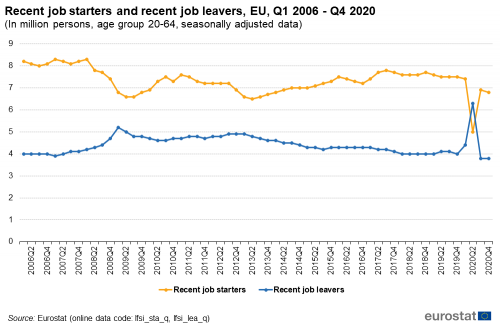
Source: Eurostat (lfsi_sta_q), (lfsi_lea_q)
When comparing the results for the last two quarters of 2020 with the long-term trend, it can be noticed that the number of recent job leavers in Q3 and Q4 2020 is at an all-time low level since the start of the time series (i.e. since Q1 2006). On the other hand, the number of recent job starters in those two quarters, although substantially higher than the number in Q2 2020, was below its level over Q2 2014 to Q1 2020. In addition, the number of recent job starters was similar to the number observed during the financial crisis from the late 2000s.
Among the population of recent job starters, men have been always more numerous than women, as shown in Figure 2. In Q2 and Q3 2020, both genders almost equalised, but in Q4 2020, the gap appeared to widen. Among the population of recent job leavers, the pattern is not so conclusive over the years: in some quarters men prevailed and in some others, women prevailed. However, in the last three quarters of 2020, the number of women was higher than the number of men among the recent job leavers.
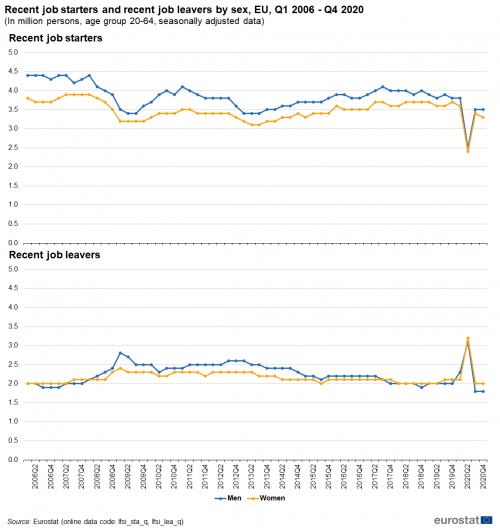
Source: Eurostat (lfsi_sta_q), (lfsi_lea_q)
Focus on recent job starters
While the previous section was using seasonally adjusted data, as looking at the evolution over time since 2006, the two next sections are based on non-seasonally adjusted data because they aim to focus on changes from 2019 to 2020, comparing one quarter of 2020 with the corresponding one in 2019.
At EU level, the number of recent job starters in Q1 2020 was 1.9 % lower than the number in Q1 2019. Comparing these two quarters, the situation among the EU Member states was diverse (see Figure 3). However, the majority of EU countries (19 out of 26 with available data) also experienced a decrease in the number of newly employed between Q1 2019 and Q1 2020. The decrease was most notable in Croatia (-30.9 %), Bulgaria (-32.4 %) and Greece (-36.5 %). In contrast, the number of recent job starters increased between Q1 2019 and Q1 2020 in the other seven EU countries, with an increase ranging from +1.8 % in Lithuania to +42.5 % in Slovenia.

Source: Eurostat (lfsi_sta_q)
The decrease in the number of recent job starters between Q2 2019 and Q2 2020 was huge in comparison with the decrease between Q1 2019 and Q1 2020 in the EU. There were one-third fewer recent job starters in Q2 2020 than in Q2 2019 (-33.6 %). All EU Member States also experienced a decline. The drop between Q2 2019 and Q2 2020 was the largest in Greece (-61.8 %). In contrast, Denmark (-7.6 %), Luxembourg (-3.6 %) and Hungary (-0.8 %) corresponded to a decrease of less than 10 %.
Looking at EU level, the number of newly employed people also decreased between Q3 2019 and Q3 2020 (-9.5 %) although to a lesser extent than between the second quarters of 2019 and 2020. Focusing on the national level, between Q3 2019 and Q3 2020, 20 Member States also registered a fall in the number of newly employed people, with the most pronounced drops in Slovenia (-22.4 %), Ireland (-23.1 %), Portugal (-32.3 %) and Slovakia (-33.8 %). In contrast, the number of recent job starters increased between Q3 2019 and Q3 2020 in the remaining six EU countries with available data, where the highest growths were found in Hungary (+26.1 %), Bulgaria (+27.5 %) and Greece (+73.3 %). It is worth noting that Greece, which showed the largest decrease in the number of recent job starters from Q1 2019 to Q1 2020 and from Q2 2019 to Q2 2020, experienced the largest increase from Q3 2019 to Q3 2020.
Consecutively, the development between Q4 2020 and Q4 2019 (-8.9 %) was similar to the development observed between Q3 2020 and Q3 2020. At a national level, 22 EU countries also registered a decrease in the numbers of newly employed from Q4 2019 to Q4 2020. The biggest drops were in Poland (-20.3 %), Slovakia (-22.8 %) and Romania (-26.0 %). Four countries were at the other side of the zero value, i.e. with a larger number of recent job starters in Q4 2020 than in Q4 2019: Lithuania (+3.6 %), Denmark (+12.4 %), Hungary (+24.9 %) and Croatia (+55.2 %). It is worth noting that the situation in Croatia was also very dynamic in 2020, as this country showed one of the biggest decrease from Q1 2019 to Q1 2020, but also the largest increase in the number of recent job starters from Q4 2019 to Q4 2020.
Figure 4 depicts the evolution of men and women in the population of recent job starters between Q4 2019 and Q4 2020. At the EU level, both genders experienced a decrease in terms of percentage change between those two quarters. However, the decrease for men was greater than the decrease for women: -10.0 % for men compared with -7.9 % for women.
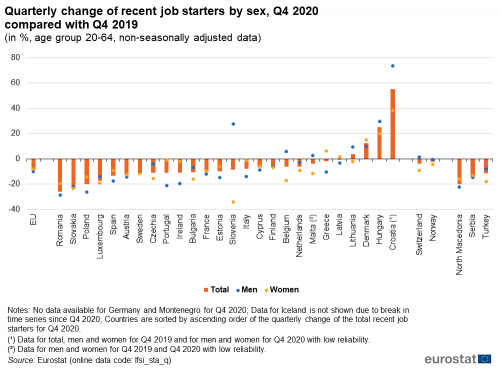
Source: Eurostat (lfsi_sta_q)
Among recent job starters, the number of men increased between Q4 2019 and Q4 2020 in only seven Member States (out of 26 for which data is available). The increase was the largest in Croatia (+73.5 %), followed by Hungary (+29.7 %) and Slovenia (+27.7 %). In the remaining 19 EU countries, the number of men who had started a job recently before the interview decreased when comparing Q4 2020 with Q4 2019. The largest cuts were in Slovakia (-22.1 %), Poland (-26.1 %) and Romania (-28.7 %).
The number of women who were recent job starters increased between Q4 2019 and Q4 2020 in few Member States, only five (out of 26 with available data). As for men, the increase for women was the most significant in Croatia (+38.3 %) and Hungary (+20.0 %), but in this case, followed by Denmark (+15.0 %) in the third place. It is worth noting that the increase for women in Croatia and Hungary is less pronounced than the increase for men. In the vast majority of Member States (the remaining 21 countries), the number of newly employed women decreased between Q4 2019 and Q4 2020. The sharpest drops were recorded in Luxembourg (-19.1 %), Romania (-19.4 %), Slovakia (-23.7 %) and Slovenia (-34.3 %). Slovenia is, therefore, the country with one of the biggest increase in the number of men among the newly employed and at the same time with the biggest cut in the number of women among this population.
Focus on recent job leavers
Between Q1 2019 and Q1 2020, the number of recent job leavers increased by 14.2 % at the EU level (see Figure 5). The majority of Member States (18 out of 25 with available data) also experienced an increase in the population of recent ex-workers. This increase was most significant in Slovenia and Romania, where the number of people who had left their jobs recently in Q1 2020 doubled and tripled respectively the corresponding number in Q1 2019. In the remaining seven EU countries, the number of recent job leavers decreased between Q1 2019 and Q1 2020, with the slowest drop in Sweden and France (-0.1 % for both), and the sharpest one in the Netherlands (-10.8 %).
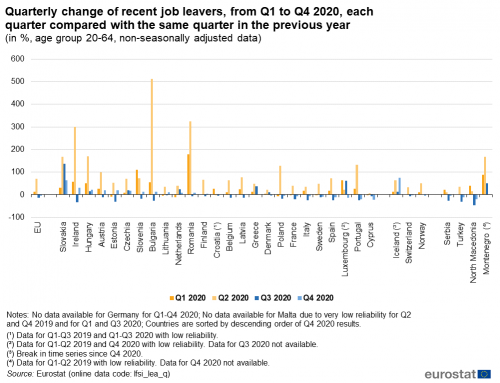
Source: Eurostat (lfsi_lea_q)
When Q2 2020 is compared with Q2 2019, the quarterly change takes much more significant dimensions than if Q1 2020 and Q1 2019 are set side by side. At EU level, the number of recent job leavers was 71.1 % higher in Q2 2020 than in Q2 2019. Only one Member State experienced a drop, namely Croatia (-1.2 %). Also, only Cyprus (+5.6 %) had an increase in the number of recent job leavers of less than 20 %. In contrast, the number of people who had left their jobs recently tripled in Hungary and Slovakia and quadrupled in Romania and Ireland between Q2 2019 and Q2 2020. The largest increase, however, was found in Bulgaria, where there were six times more recent job leavers in Q2 2020 than in Q2 2019.
The quarterly change in the number of recent job leavers between Q3 2019 and Q3 2020 at the EU level was -14.2 %. The majority of Member States (18 EU countries out of 25 with available data) had a reduction in the population of new ex-workers in Q3 2020 compared with Q3 2019. The decrease was the most notable in Ireland (-34.2 %), followed by Estonia (-31.3 %) and Bulgaria (-25.8 %). It is worth noting that Ireland and Bulgaria both had a very large percentage increase in recent job leavers between Q2 2019 and Q2 2020. On the contrary, the number of recent job leavers rose in the remaining seven EU countries, with increases ranging from +9.9 % in Denmark to +136.5 % in Slovakia. This makes Slovakia the Member State with the largest increase in the number of recent job leavers, and also with the largest decrease in the number of recent job starters (as seen in the previous section) between Q3 2019 and Q3 2020.
From Q4 2019 to Q4 2020, the number of recent job leavers dropped by 4.0 % at the EU level. Nine EU countries also had a lower number of recent job leavers in Q4 2020 than in Q4 2019. The cut ranged from -3.6 % in Denmark to -22.1 % in Cyprus. In Greece, the number of recent job leavers remained stable. Furthermore, in 15 other Member States, the group of recent job leavers increased its size. Same as from Q3 2019 to Q3 2020, and from Q4 2019 to Q4 2020, Slovakia (+63.0 %) had the largest increase in the number of people who had left their jobs recently. Following Slovakia, Ireland (+31.2 %) and Hungary (+22.0 %) had the second and third largest increase in the number of this category.
The next figure of the article (i.e. Figure 6) displays the change between Q4 2019 and Q4 2020 in the number of men and women who had left their job recently. At the EU level, the number of men in this situation decreased by 5.1 %, whereas the number of women dropped by 2.8 %.

Source: Eurostat (lfsi_lea_q)
All in all, the number of women recent job leavers was larger in Q4 2020 than the number recorded in Q4 2019 in more than half of the Member States (14 countries out of 24 with available data). Slovakia had the highest increase in the number of female recent job leavers, with two times as many women in this category in Q4 2020 than in Q4 2019. It is also worth mentioning that Slovakia had the largest difference between the quarterly change for men and women. In this country, men who had left their job recently in Q4 2020 were with one quarter more (+24.8 %) than in Q4 2019, while the quarterly change for women was +122.1 % (i.e. 97.3 percentage points higher). Following Slovakia by a wide margin, Ireland (+35.1 %) and Slovenia (+21.6 %) experienced the greatest increase in the number of women among recent job leavers. On the opposite side of the scale, nine EU countries had a lower number of women recent job leavers in Q4 2020 than in Q4 2019, with the largest reductions found in Spain (-14.5 %), Croatia (-23.1 %) and Portugal (-25.2 %). Finally, Denmark had the same number in Q4 2019 and Q4 2020.
On the other hand, the number of men among recent job leavers decreased in 10 EU countries. The decrease for men was biggest in Portugal (-16.2 %), Sweden (-21.3 %) and Cyprus (-42.2 %). Out of the 14 EU countries, which had an increase in the number of recent job leavers from Q4 2019 to Q4 2020, Estonia (+63.0 %), Croatia (+47.5 %) stand out as the countries to record the most sizable increases but the results for them are with low reliability. Following Estonia and Croatia, the increase for men was the highest in Austria (+34.0 %), Ireland (+27.6 %) and Lithuania (+26.2 %).
Ratio of recent job leavers to recent job starters
This section of the article aims to answer whether recent job leavers were more than recent job starters throughout 2020. As previously stated, at EU level recent job leavers in Q2 2020 were more than recent job starts. Figure 7, which utilises non-seasonally adjusted data, also confirms: the ratio of the number of recent job leavers to the number of recent job starters in Q2 2020 was 108.3 %, implying that in this quarter recent job leavers were 8.3 % more than those who started work recently.
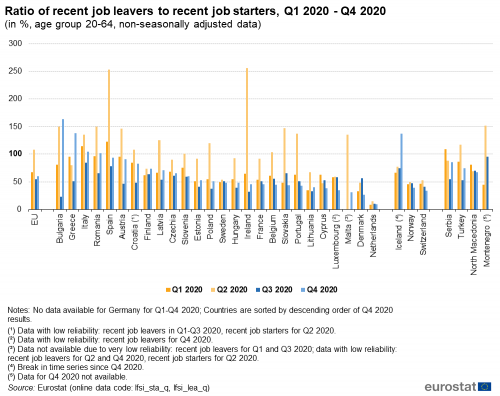
Source: Eurostat (lfsi_sta_q), (lfsi_lea_q)
This phenomenon was observed already in Q1 2020 in Spain and Italy, where the number of recent job leavers was 23.0 % and 14.4 % respectively higher than the number of recent job starters (ratios of 123.0 % and 114.4 %).
Following that, in Q2 2020, 14 Member States (out of 26 with available data), had a ratio surpassing 100 %, i.e. these countries had more recent job leavers than recent job starters. The highest ratios were in Spain (253.1 %) and Ireland (255.8 %) where the number of recent job leavers nearly tripled those of recent job starters.
In Q3 2020, in all EU countries, the ratio dropped below 100 % with lower levels of recent job leavers than recent job starters. Then, in Q4 2020, four Member States were above the 100 % mark, with more recent job leavers than recent job starts. These were Romania, Italy, Greece and Bulgaria, where people who had left their job recently were respectively 2.2 %, 4.5 %, 37.9 % and 63.3 % more than the newly employed.
Source data for tables and graphs
Data sources
All figures in this article are based on quarterly results from the European Union Labour Force Survey (EU-LFS).
Source: The European Union Labour Force Survey (EU-LFS) is the largest European household sample survey providing mostly quarterly and annual results on labour participation of people aged 15 and over as well as on persons outside the labour force. It covers residents in private households. Conscripts in military or community service are not included in the results. The EU-LFS is based on the same target populations and uses the same definitions in all countries, which means that the results are comparable between countries.
European aggregates: EU refers to the sum of the EU-27 Member States. If data is unavailable for a country, the calculation of the corresponding aggregates is computed with estimates. Such cases are indicated.
Country note: In Germany, from the first quarter of 2020 onwards, the Labour Force Survey (LFS) has been integrated into the newly designed German microcensus as subsample. Unfortunately, for the LFS, technical issues and the COVID-19 crisis have had a large impact on data collection processes, resulting in low response rates and a biased sample. For this reason, the full sample of the whole microcensus has been used to estimate a restricted set of indicators for the four quarters of 2020 for the production of LFS Main Indicators. These estimates have been used for the publication of German results, but also for the calculation of EU and EA aggregates. By contrast, EU and EA aggregates published in the Detailed quarterly results (showing more and different breakdowns than the LFS Main Indicators) have been computed using only available data from the LFS subsample. As a consequence, small differences in the EU and EA aggregates in tables from both collections may be observed. For more information, see here.
For more information on recent job starters and leavers, please consult pages 22, 41-43 and 80-82 from EU Labour Force Survey Explanatory Notes
Also, five different articles on detailed technical and methodological information are available from the overview page of the online publication EU Labour Force Survey.
Context
The COVID-19 pandemic hit Europe in January and February 2020, with the first cases confirmed in Spain, France and Italy. COVID-19 infections have since been diagnosed in all European Union (EU) Member States. To fight the pandemic, EU Member States have taken a wide variety of measures. From the second week of March, most countries closed retail shops, with the exception of supermarkets, pharmacies and banks. Bars, restaurants and hotels were also closed. In Italy and Spain, non-essential production was stopped and several countries imposed regional or even national lock-down measures which further stifled economic activities in many areas. In addition, schools were closed, public events were cancelled and private gatherings (with numbers of persons varying from 2 to over 50) banned in most EU Member States.
The majority of the preventative measures were taken during mid-March 2020, and most of the measures and restrictions in place for the whole of April and May 2020. The first quarter of 2020 was consequently the first quarter in which the labour market across the EU was affected by COVID-19 measures taken by Member States.
Employment and unemployment as defined by the ILO concept are, in this particular situation, not sufficient to describe the developments taking place in the labour market. In the first phase of the crisis, active measures to contain employment losses led to absences from work rather than dismissals, and individuals could not look for work or were not available due to the containment measures, thus not counting as unemployed.
Direct access to
<maintables>
Main tables
<maintables>
